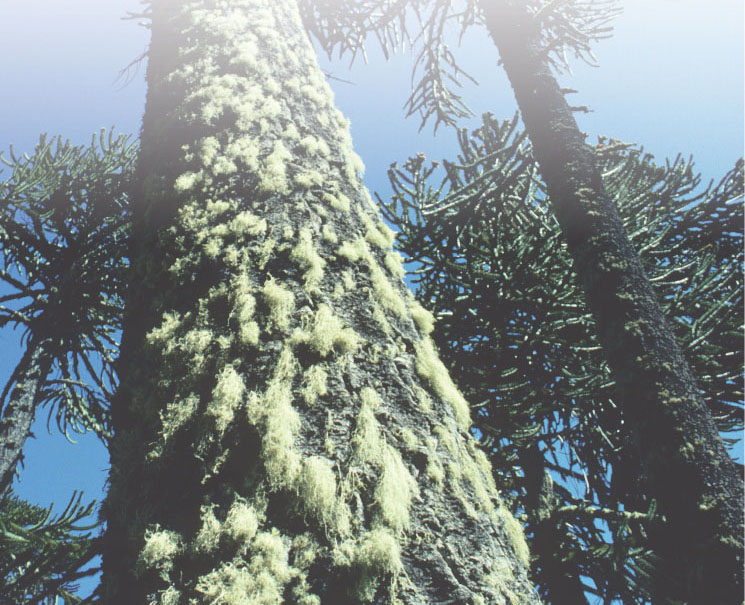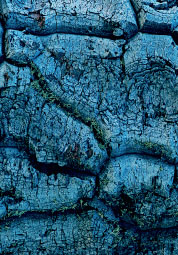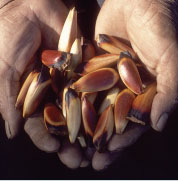
BOTANICAL NAME
Araucaria araucana
DISTRIBUTION
Today restricted to two small areas along the coast of central Chile and a larger area in the Cordillera of the Andes, on the borders of Chile and Argentina.
OLDEST-KNOWN LIVING SPECIMEN
Approximately 2,000 years old — no exact location known.
RELIGIOUS SIGNIFICANCE
Sacred to the Pehuenche people of south-central Chile, who regard it as a ‘mother’. They believe that God created monkey puzzle trees for them, and that it is their duty to protect them. Also a national monument of Chile.
CONSERVATION STATUS
Classified on the IUCN Red List of Threatened Species in 2000 as ‘vulnerable – facing a high risk of extinction in the wild’.
Because monkey puzzles are sacred to the Pehuenche people they have fought to protect magnificent forests like this one.
The monkey puzzle, with its strangely prehistoric shape, is an extraordinary tree. Many fine specimens can be seen gracing gardens and parks around the world, but their true home is the volcanic slopes of the high Andes mountains of southern South America. Here the monkey puzzle thrives in an inhospitable terrain. Amid volcanic debris, and often clinging to precipitous slopes and the crests of hills, it seems impervious to the extremes of heat, cold and hurricane-force winds. The trees are adapted to the harshest of living conditions, including volcanic eruptions and heavy falls of winter snow.

Mosses and lichens growing on the straight trunks of monkey puzzles high in the Chilean Andes.
Sometimes referred to as living fossils, monkey puzzles (Araucaria araucana) have an extremely ancient heritage. Remains of trees belonging to the same family have been found, fossilized, in rocks that were formed during the Jurassic period, some 225 million years ago. About 190 million years ago, the trees were one of the dominant species of the southern hemisphere, with a range that stretched from Brazil to Antarctica. Today, however, monkey puzzles are found in only a very restricted region: two small areas in the Cordillera of Nahuelbuta along the coast of central Chile, and a larger area in the Cordillera of the Andes on the borders of Chile and Argentina. Preferring north- and west-facing slopes, they grow primarily on volcanic soils, about 600–1,800m (2,000–6,000ft) above sea level. The trees grow both in pure stands and in association with other trees, notably species of southern beech (Nothofagus spp.).
While young monkey puzzles resemble a pyramid or cone in shape until they begin to lose their lower branches, at about 100 years old, mature trees are distinguished by their well-defined crown, which develops some 18–30m (60–100ft) above the ground, giving them the appearance of an open umbrella.

The rosette formation of spiky leaves at the tip of a monkey puzzle branch.
Monkey puzzles can live to a great age. It is not uncommon to find individuals of over 1,300 years old; the oldest are believed to be around 2,000 years old. Growing very slowly, mature monkey puzzles develop perfectly straight, column-like trunks, which can reach some 50m (165ft) in height and measure 2.5m (8ft) in diameter at breast height. The trees also develop a remarkable bark with a fascinating honeycomb pattern. In mature trees, the bark can be up to 18cm (7in) thick and may account for up to 25 per cent of the trunk’s volume. It plays an important role in protecting the tree from the extremes of the Andean climate and, importantly, is able to resist the intense heat of volcanic eruptions.

Monkey puzzles’ fire-resistant bark can be 18cm (7in) thick, helping them survive the eruptions of active volcanoes in the Chilean Andes.
Like the bark, the curious triangular leaves of the monkey puzzle are extremely tough. They are arranged in spirals and are attached directly to the twigs and branches of the trees, and to the young trunk in early life. It is the curious arrangement of leaves and branches that was responsible for the tree’s common name of ‘monkey puzzler’, which came into use during the late nineteenth century. Although monkeys did not live in the forests of Chile, early European observers thought that the trees would present any monkey with a challenge! According to Maud Woodcock, writing in the 1940s, ‘The monkey’s puzzle consists in the monkey being able to go up the sharp points of the tree but not down them’.
While they do not support monkeys, the trees do provide the habitat for a number of rare and endangered animals. These include the puma, the Chilean pigeon and the slender-billed parakeet. One of the principal foods of the parakeet is the seed, produced by the female monkey puzzle tree, inside cones that can grow to the size of a person’s head. Individual cones may contain about 200 tapering seeds, each about 4cm (1½in.) long. Though they consume many seeds, the parakeets also play a part in their distribution – as they force their sharp beaks inside the cones, the cones split, releasing the seeds, which fall to the ground. The existence of certain dense groupings of monkey puzzle trees is said to be due to the activity of mole rats, which also inhabit the Chilean forests and bury quantities of seeds each year.
It is the connection between monkey puzzle trees and people that is perhaps the most significant aspect of their existence. One of South America’s native peoples takes its name directly from the tree, since their culture and identity have been shaped by it. These people are the Pehuenche, whose name means ‘people of the monkey puzzles’ – from pehuen, meaning ‘monkey puzzle’, and che, meaning ‘people’. About 5,000 Pehuenche people currently live in the valley of the upper Bio-Bio, the longest river in the south-central region of Chile. The Pehuenche are traditionally a resilient and independent people – part of the great Mapuche nation, the indigenous population of half the area that is today known as Argentina and Chile, whom the Incas never managed to conquer and who remained beyond the control of both the Chilean and Argentinian republics until just over 100 years ago.

Monkey puzzle seeds (piñones) are an essential part of the Pehuenche diet.
For part of each year, during late summer and early autumn, the Pehuenche live mainly as food-gatherers in the upland volcanic forests, collecting the nutritious monkey puzzle seeds. These golden-brown seeds, known as piñones in Spanish, are the Pehuenche’s traditional staple food. They are gathered both for immediate consumption and for storage, to be eaten throughout the year, forming the main source of carbohydrate during the long winter from June to September. The harvesting of piñones is a skilful job. Some seeds will be picked up from the ground where they have fallen naturally, but Pehuenche men also scale the trees with the aid of ropes, carrying long, thin poles with which to knock down more seeds. They strike the ripe cones, which usually shatter when they are hit, sending showers of seeds falling to the ground, where women and children quickly gather them. Large numbers of piñones are often gathered during the harvest: a single family may be able to collect as much as 3,000kg (6,630lb) of seeds each year, although in some years the trees produce smaller quantities. The Pehuenche are careful, however, not to knock down all the cones from the trees or collect all the seeds from the ground, mindful that enough must be left to allow regeneration.

A Pehuenche man on horseback, in the bitter winter conditions that occur high in the Andes.

A Pehuenche family collecting protein-rich monkey puzzle seeds – an important food source during winter.
Piñones are similar to sweet chestnuts in texture and taste and are generally boiled or roasted, after which the tough outer skin is removed. They may also be ground into a coarse flour used in soups and for making bread, or turned into a nutritious fermented drink. Monkey puzzle seeds are fed to animals, too. The Pehuenche once obtained their meat by hunting wild guanaco, a relative of the domesticated llama, but today they tend to keep small numbers of sheep and goats, and the occasional horse. During the long, harsh winters, when nearly 2m (6ft) of snow can cut off some of the remoter communities from the outside world, piñones form a useful animal feed.
Many families also sell a proportion of the seed harvest to traders, who may travel long distances to buy direct from the Pehuenche. The piñones are then resold in lowland towns and in regional and provincial capitals, as well as the national capitals, Santiago and Buenos Aires. The Pehuenche are generally paid very little for the seeds, but the money that they generate is vital to enable them to buy many of the goods they need, including clothing and items of hardware, from nearby villages and towns.
The monkey puzzle tree is like a mother to the Pehuenche. It is sacred, revered and respected. They may speak to it, bless it and pray to it in the course of their daily lives. The Pehuenche regard the monkey puzzle forest as part of their extended family, or lofpehuen, and as the origin of their own ancestry. The male tree, wentrupehuen, and the female tree, domopehuen, are believed to reproduce through the connection of their extensive root system, while two old trees are thought to protect the forests. Before the harvest begins, Pehuenche communities traditionally perform a special ceremony in order to ask permission to collect the seeds and ensure that the harvest will be good. A particular tree is selected, around which special prayers are said. This young tree is seen as a magical bridge between Earth and the cosmos beyond. Some Pehuenche make a pilgrimage every year to the site of one particular sacred monkey puzzle tree located north of the Bio-Bio River.

With its remarkably straight trunk, the monkey puzzle was considered one of the most valuable timber trees of the southern Andes during colonial times.

The monkey puzzle is our tree. It’s a symbol for us. It’s a tree that God left on Earth, for us, the Pehuenche. We cannot cut it down, because it gives us our daily bread. In the end, we would rather die than give up defending this tree.
ALFREDO MELINIR (LONQO OR CHIEF OF THE PEHUENCHE COMMUNITY NEAR LONQUIMAY), 1996

Nguillatun – an ancient Mapuche festival
Each year, a special ceremony led by a religious leader or machi is performed by the Mapuche at harvest time. This is to thank the spirit world, to ask for protection, and to ensure that the next harvest will be plentiful. It is to ask, too, for an increase in their flocks of sheep and other livestock, and for the long life of their children and elders. For two to four days, prayers, singing, dancing and feasting take place. Wearing their traditional ponchos and special ceremonial headdresses made of feathers, the men of the group perform a sacred dance around an altar bearing branches from certain trees, and offerings to the earth are made.
The Pehuenche believe that everything, including the forest, has its own spirit, or pulli, and that an equilibrium exists in nature that should not be upset by human beings. Although pieces of old dead wood – often found where the branches protrude from the trunk – are used as firewood, to fell a monkey puzzle would be unthinkable to them.
Since the 1800s, the monkey puzzle forests of Chile and Argentina have been over-exploited by national and international businesses. The timber has been used for many purposes including the construction of train rails, tunnels, ship masts, aeroplane bodies, ceilings, floorings, furniture, pianos, skis, beams for mine construction and, in recent years, to produce cellulose for paper pulp. Logging has not only been carried out without the consent of the Pehuenche or the acknowledgement of their traditional lands, but also largely without reforestation. Today deforested areas have been mostly replaced by farmland or plantations of rapidly growing exotic trees such as eucalyptus.
Monkey puzzle trees are protected under Appendix I of CITES (Convention on International Trade in Endangered Species of Wild Fauna and Flora) and in Chile felling has also (since 1990) been banned other than for scientific purposes. The monkey puzzle is also the national tree of Chile. However, the species is facing a high risk of extinction in the wild because of a severely reduced and fragmented distribution, and the fact that trees continue to be felled illegally both inside and outside national parks. This view is supported by data gathered by the UN Environment Programme World Conservation Monitoring Centre, which analysed satellite images of monkey puzzle forests as far back as 1977. It found that by the first few years of the twenty-first century (2003), the forest had been reduced by 64 per cent and that the remaining forest has become highly fragmented.
Mature monkey puzzles have evolved to withstand fire and to be able to regenerate, given time, from seedlings or root suckers. However, a series of serious fires in recent decades, which appear to have been started in suspicious circumstances and which have given loggers an excuse to clear large areas of burnt trees, have been the cause of much forest loss. Major fires broke out on Pehuenche land near the small town of Lonquimay during the 1990s, incensing the local people. Ricardo Meliñir, the lonqo or spiritual leader of the community of Quinquén, said at the time: ‘After all these years defending the trees, it’s a scandal. We want people everywhere to know what has happened here.’ More fires, reported to have destroyed nearly 30,000 ha (115 sq. miles) of native forest, occurred in the summer season of 2001–2002. The worst-affected area was the Malleco National Reserve, which saw 71 per cent of the Araucaria forest destroyed. A number of individual trees were believed to have been more than 2,000 years old.

A magnificent stand of monkey puzzles on the slopes of the Lonquimay Volcano in south central Chile.

The most remarkable thing about the trees was the bark … a perfect child’s puzzle of knobbly slabs of different sizes, with five or six decided sides to each, and all fitted together with the neatness of a honey-comb.
MARIANNE NORTH, RECOLLECTIONS OF A HAPPY LIFE, 1892

Over the years, groups of Pehuenche from many different locations have tried to stop the depletion of monkey puzzle forests by timber traders. Since 1976, efforts to protect the remaining forests have been also been attempted by CONAF (Cooporación Nacional Forestal), with the setting up of national reserves, but the restrictions placed on the movements and activities of the Pehuenche have led to considerable tensions and problems. International NGOs have tried to assist, but projects have tended to not fully appreciate the enormous and profound knowledge that Pehuenche people themselves have with regard to the management of their forest.
In response to what has been regarded as inappropriate outside help, different villages and groups of Pehuenche have formed indigenous organizations, such as the Associación Indígena Mapuche Pewenche de Ikalma ‘Markan Kura’, formed in 2001. They have undertaken a variety of projects, communally, to enhance biodiversity (such as the reforestation of degraded areas), based on indigenous knowledge and which respect their own cultural identity. This model of conservation respects the fact that the Pehuenche have profound ecological knowledge based on centuries of natural resource management.
Like so many other indigenous peoples worldwide, the Pehuenche have suffered badly from the repeated refusal of others to respect their rights and their ancestral land. Much of the extensive monkey puzzle forests that once supported them has been destroyed. But the Pehuenche are a proud and tenacious people and it is largely due to their efforts that monkey puzzles remain today.

A Pehuenche man in an area of destroyed monkey puzzle forest near Lonquimay.
Monkey puzzle trees thrive in an inhospitable climate, and can survive extremes of heat in summer as well as heavy falls of winter snow.